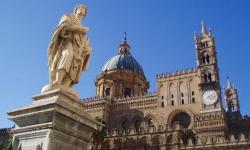The Cathedral of Palermo is an architectural complex in Palermo, Italy and is characterized by the presence of different styles, due to a long history of additions, alterations and restorations, the last of which occurred in the 18th century. The Cathedral of Palermo is located at Corso Vittorio Emanuele, corner of Via Matteo Bonello, Palermo, Italy
The Cathedral of Palermo,is known officially as "Santa Maria Assunta" or Saint Mary of the Assumption. Some scholars believe that a temple existed here in Roman, or possibly even Punic, times. There is no doubt that the site once had a large Byzantine Greek (Orthodox) church. Arab records mention the existence of a large "pagan" temple present on this site when they conquered Palermo in 831. This was turned into a mosque. In 1072, when the Normans wrested control of Palermo from the Saracens, Count Roger promptly saw to it that the Great Mosque was reconsecrated as a Christian church. The present cathedral was not completed for another century, and greatly modified through the ages.
In 1185, the English Archbishop of Palermo, Walter of the Mill, assumed responsibility for the completion of the cathedral. We know not precisely when the remains of Odo of Bayeaux, brother of William the Conqueror, were interred here, but it may have been while Walter was bishop.
The Cathedral of Palermo, underwent major changes in the following centuries, manifested in the form of renovations and additions, such as the cupola constructed in 1785. This dome, and the extensive Baroque reconstruction of the interior, completely defaced the beautiful Norman Arab arches and lines of the inside of the church and corrupted the exterior's intended effect.
The church is a massive rectangular structure, with two towers at the two front corners constructed in the Norman Arab style. The exterior of the apse is similar to those of Monreale Cathedral and the smaller Basilica of the Magione. An interesting exterior detail is the repeating horizontal inlay motif of the lions "passant guardant" visible near the apse. This became the heraldic symbol of England, and it might be suggested that Walter added it here as an allusion to his own island. Yet, its presence in the older Palatine Chapel suggests that the symbol was used in Sicily long before it was employed by the Norman Kings of England.
The chapel that is located near the main entrance of the church is famous for its royal tombs. It is here that King Roger II is buried, along with his daughter, Constance de Hauteville, mother of Emperor Frederick II Hohenstaufen, who is also laid to rest here. Henry VI Hohenstaufen, Holy Roman Emperor, father of Frederick and husband of Constance, is also entombed here. Frederick II, who besides being the King of Sicily was the Emperor of the Germans, has not been forgotten by the modern-day descendants of his Teutonic subjects. Even though Frederick has been dead for more than seven centuries, don't be surprised if you see German tourists leaving flowers at the foot of the Emperor's tomb.
The Cathedral of Palermo, has a treasury that is a Museum containing an assortment of finely crafted religious objects. There are illuminated manuscripts here and bejeweled chalices and crucifixes, along with sophisticated gold Jewelry adorned with Byzantine enamel ware. The treasury's most famous object is the Crown of Constance, a masterpiece of twelfth century metalwork combining Byzantine, Arabic and Western elements situated in the Museum.



The Cathedral of Palermo reviews
Login to comment